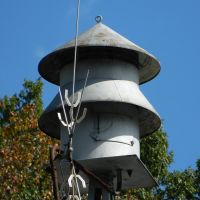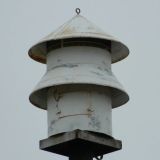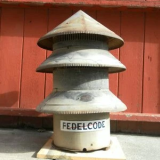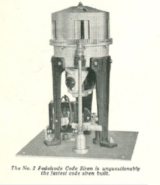Fedelcode
| Fedelcode | |
 A Fedelcode Type Mach. 7 C3 1/2, located in Tryon, NC. Photo taken by Christopher J. (TrainsAndSirens1). | |
| Company | Federal Electric Company |
|---|---|
| Produced | 1929-1948 |
| Type | Omnidirectional Electromechanical |
| Sound output | Varies |
| Frequency | 50/60 Hz |
| Horsepower | 1-10 hp |
| Preceded by | Federal Electric Type Mach. B |
| Succeeded by | |
Fedelcode (short for Federal Electric Code) is a series of sirens that was produced by the Federal Electric Company in the early to mid-20th century. Intended to replace the obsolete Type Mach. B and better compete in the general purpose and fire siren markets, these sirens were popular for their strong performance and reliability. As the name suggests, all Fedelcode sirens were offered with coding dampers of various designs, which allowed the siren to create coded "pulse" signals.
History
WIP

The Fedelcode line of sirens debuted in 1929, with several single and dual headed models being available. These sirens were intended for use on fire stations and other places where coded signaling was required, and offered superior performance and reliability than the existing Type B. It is speculated that the dual rotor sirens were Federal's "premium" siren offering, as these sirens incorporated design features that improved their performance compared to the more common, cheaper single rotor series of sirens. These sirens quickly began to sell well as word spread around. These were produced both under the Federal Electric and Fedelcode branding, with Fedelcode variants having large metal "Fedelcode" badges advertising the brand. Around the same time, the Model 2 would be released under the Fedelcode name, although it became its own separate siren and shares little in common with the other Fedelcode. Though the tags on these sirens refer to them with a "Type Mach." prefix, colloquially they are often referred to with a "Model" prefix. The dual rotor Fedelcodes would be only vertical dual rotor sirens Federal made until the XT22 debuted in 1952. At some point around 1930, the Fedelcode line of sirens would include several new models. These sirens varied in shapes and sizes, ranging from 1 hp all the way to 20 hp. There were three main rotor sizes, designated on the tag as "Type Mach. C1 ½" (13" rotor), "Type Mach. C2 ½" (15" rotor) and "Type Mach. C3 ½" (17" rotor). The sirens are often named after their horsepower rating; however, this is unreliable as the horsepower varies even with the same rotor sizes. The spring-operated damper coded sirens used were substitute for a more reliable spring-actuated mechanism at some point in time. Fedelcode was and succeeded by the Model 5 line in 1948, which carried over models 1, 2, C1 ½, C2 ½, and C3 ½.
Design
Dual rotor
Type Mach. 1

The Type Mach. 1 (not to be confused with the smaller siren of the same name) is the lowest power option in the original Fedelcode line, being a single rotor vertical electric siren, and the only single rotor siren in the dual series lineup. Unlike the other Fedelcode sirens, the Type Mach. 1 was intended as a "general alarm", with no coding capabilities. The Type Mach. 1 was available with a 9-port or 12-port single tone rotor and stator, driven by a General Electric square-shaped 1 hp AC motor. The rotor itself is 10½, a size it shares with the Type Mach. 3. Unlike every other outdoor warning siren Federal has made, dual rotor Fedelcode sirens used curved vanes on the rotors, which makes them more efficient. This was likely to improve their performance over the single headed models. While the Type Mach. 1 is a single rotor siren, it is included here as it is a unique single rotor version of the dual rotor sirens; as such, the Type Mach. 1 was also available with curved vanes originally. The Type Mach. 1 uses a weatherproof housing that slightly resembles those used in later Fedelcode models, being cylindrical in shape with 2 skirts directing the sound from the rotor ports outwards. A rain shield on top which helps protect the siren from the elements and directs the sound from the siren's intake outwards. The siren uses a rotor-over-motor configuration, with the siren's intake facing upwards. The siren's design projects all of the siren's output both downwards and outwards in a 360° fashion, which makes it perfectly suitable for roof mounting. The siren uses a mesh screen to keep debris out of the rotor. The Type Mach. 1 was 1 of the poorer selling sirens, with few units still existing today, some with their original "FEDELCODE" labels.
Type Mach. 3 (Dual rotor)

The dual rotor Type Mach. 3 is the smallest dual rotor siren in the original lineup, using the same 10½ rotors that the Type Mach. 1 has. The Type Mach. 3 is essentially a dual rotor variant of the Type Mach. 1, but unlike the Type Mach. 1, the Type Mach. 3 has coding capabilities. The Type Mach. 3 makes use of 2 rotors, available in 9/9, 12/12, or 9/12-port. The siren is driven by a dual sided General Electric 3 hp AC motor between the 2 rotors. The siren uses a tall cylindrical weatherproof housing, and each rotor/stator has 2 skirts that help project the sound both outwards and downwards. The siren also has a rain shield which both protects the siren itself and projects the sound from the upper rotor's intake. The Type Mach. 3 was available with coding dampers fixed to each intake, which could allow the siren to create coded pulse signals. The mechanism uses a spring or solenoid-actuated coding damper using a rotating disk resting in the open position over the intake and lowering to silence the siren for coding allowing the siren to perform coded pulse signals for fires or other unique purposes. This damper has a bearing which allows it to spin with the rotor, which reduces drag and potential damage to the rotor. These dampers were optional and were designed to be easily added to or removed from the siren as required. The siren also used a mesh screen to protect each rotor. The Type Mach. 3 was successful, although not to the degree of the larger models.
Type Mach. 5 (Dual rotor)



The dual rotor Type Mach. 5 is the midrange option in the original lineup, and 1 of the bestselling models. The Type Mach. 5 makes use of 2 16" rotors/stators, driven by a 5 hp dual sided General Electric AC motor. The siren was available in a multitude of ports, including 6/6, 8/8, and 12/12-port single tone, or 6/12-port dual tone. No 8/12 or 6/8-port models have been documented and may never have been made. The siren uses a tall cylindrical weatherproof housing, and each rotor/stator has 2 skirts that help project the sound both outwards and downwards. The siren also has a rain shield which both protects the siren itself and projects the sound from the upper rotor's intake. The skirts on the Type Mach. 5 were originally smaller than those used on the Type Mach. 3, though this was changed later in the siren's production with larger skirts that sloped downwards at a steeper angle, and 1 skirt was removed. The Type Mach. 5 was available with coding dampers fixed to each intake, which could allow the siren to create coded pulse signals. The mechanism uses a spring or solenoid-actuated coding damper using a rotating disk resting in the open position over the intake and lowering to silence the siren for coding allowing the siren to perform coded pulse signals for fires or other unique purposes. This damper has a bearing which allows it to spin with the rotor, which reduces drag and potential damage to the rotor. These dampers were optional and were designed to be easily added to or removed from the siren as required. The siren also used a mesh screen to protect each rotor. The Type Mach. 5 was the most successful model, with several surviving in service today, often as fire sirens or noon whistles.
Type Mach. 10 (Dual rotor)

The dual rotor Type Mach. 10 is the largest siren in the original lineup, and easily the loudest. The Type Mach. 10 makes use of 2 large 24" rotors/stators, driven by a 10 hp dual sided General Electric AC motor. The siren was available in a multitude of ports, including 6/6, 8/8, and 12/12-port single tone, or 6/12-port dual tone. No 8/12 or 6/8-port models have been documented and may never have been made. The Type Mach. 10 has been said by those who have heard it to be louder than even a Cyclone 125, although this has not been tested. The siren uses a tall cylindrical weatherproof housing, and each rotor/stator has 2 skirts that help project the sound both outwards and downwards. The siren also has a rain shield which both protects the siren itself and projects the sound from the upper rotor's intake. The skirts on the Type Mach. 10 are much shallower than the other models. The Type Mach. 3 was available with coding dampers fixed to each intake, which could allow the siren to create coded pulse signals. The mechanism uses a spring or solenoid-actuated coding damper using a rotating disk resting in the open position over the intake and lowering to silence the siren for coding allowing the siren to perform coded pulse signals for fires or other unique purposes. This damper has a bearing which allows it to spin with the rotor, which reduces drag and potential damage to the rotor. These dampers were optional and were designed to be easily added to or removed from the siren as required. The siren also used a mesh screen to protect each rotor. The Type Mach. 10 sold fairly well, with several surviving units. At least 1 6/6-port unit is currently active.
Single rotor
Type Mach. C1 ½
WIP
Type Mach. C2 ½
WIP
Type Mach. C3 ½

The Type Mach. C3 ½ is the largest single-rotor Fedelcode that Federal had to offer. The Type Mach. C3 ½ came in a variety of housing styles and motor horsepower, ranging from 5 to 20 hp. The C3 ½ came standard in 8 or 12-port single tone as standard, though 9/12 dual tone was also an option late in production. The C3 ½ was available in 1, 2, or 3 ph power. The C3 ½, like the other Fedelcode single rotor models, uses a rotor-over-motor configuration, with air being drawn through the intake on the top of the siren. The rotor itself uses all long vanes, and the stator is held onto the motor by four support struts. The C3 ½ makes use of a weatherproof housing, which protects the siren from the elements. This housing was designed for rooftop mounts in mind, as it was the most common mounting configuration during this era. As such, the housing has a steep skirt with an opening around the rotor that projects most of the siren's output downwards, where it would bounce off the roof and outwards.
This had undesirable results for units mounted on poles, and several stations would modify their sirens to change the skirt angle. A second opening is located under the siren's rain shield, where air is drawn into the intake. The rain shield also catches the sound emitted from the intake and projects it outwards onto the skirt, where it's projected outwards. This design would prove to be very efficient and would be improved upon in Federal's later Model C3 ½. A removable service panel is located on the lower section of the housing, which allows for easier maintenance, and an eyebolt is located on top of the rain shield for mounting purposes. Like other Fedelcode models, the C3 ½ was available as a code siren, with a spring or solenoid-actuated coding damper using a rotating disk resting in the open position over the intake and lowering to silence the siren for coding allowing the siren to perform coded pulse signals for fires or other unique purposes. This damper has a bearing which allows it to spin with the rotor, which reduces drag and potential damage to the rotor. Some coded units have a unique housing with an additional skirt, though most have a standard housing style.
Type Mach. 1

The Type Mach. 1 (not to be confused with the larger siren of the same name) is a small vertical electric siren that was produced during the Fedelcode era. The siren uses a 9" 8-port rotor and stator, driven by a 1 hp AC/DC universal motor running at 5000 rpm as standard. Due to the drag of the rotor causing problems when correctly wired, the Type Mach. 1 was shipped by Federal Electric wired in reverse as standard, which hampered the siren's performance but improved the longevity of the motor. The Type Mach. 1 came in a variety of different housings, with 4 being known to exist. The first is a single louvre design that heavily resembles a C1 ½ housing in design. A 2-louvred version of this housing also exists, with an additional louvre helping to project the sound from the rotor outwards rather than just downwards. The 2-louvred housing had a variant that had a larger gap between the 2 louvres, with a mesh screen in between. Finally, a variant exists with three closely spaced louvres around the rotor, and a slightly tapered cylindrical housing. On all of these units, a rain shield is located on top. Despite having half the horsepower, the Type Mach. 1 is nearly twice the size of a Type Mach. 2 and performs roughly the same.
Type Mach. 2
Main article: Federal Signal Model 2

The Type Mach. 2 is a small omnidirectional siren produced under the Fedelcode name from 1929 until 1948. The Type Mach. 2 uses a 2 hp universal motor to drive a small, 5-port single-tone chopper at 6,000-8500 rpm, which allows the siren to reach roughly 102 dB at 100 ft. 3 mounting legs are located below the rotor and stator assembly, and are larger than their modern counterparts, earning Fedelcode-era Type Mach. 2 sirens the "long-legged" nickname. The earliest Type Mach. 2 units using a housing that looked similar to later Fedelcode sirens. This was then switched to a 3-louvered design, with 2 louvres on top, and 1 on the bottom. These units lacked an intake cone, so they weren't as effective as later models. Their motors also had 4 brushes instead of the 2 that are used today.

The Fedelcode Type Mach. 2 could optionally come with a coding mechanism allowing it to make a pulse signal, and these units were dubbed the "No. 2 Fedelcode Code Siren". Coded signals were achieved using a rotating coding ring on the stator, instead of a damper. This ring was driven by a Trombetta CR9500 silonoid, and this would rotate a second stator to block the stator ports, nearly silencing the siren instantly. When the motor was de-energized, the second stator would move back out of the way, allowing the siren to instantly return to full output. Due to the fast-acting mechanism, the coding on this siren was fast enough that it was claimed to be capable of creating Morse code signals, something that damper-equipped sirens are unable to do. Federal Electric units were identical to the Fedelcode units, except for lacking the coding option and having a "FEDERAL" badge instead of "FEDELCODE" on the housing.